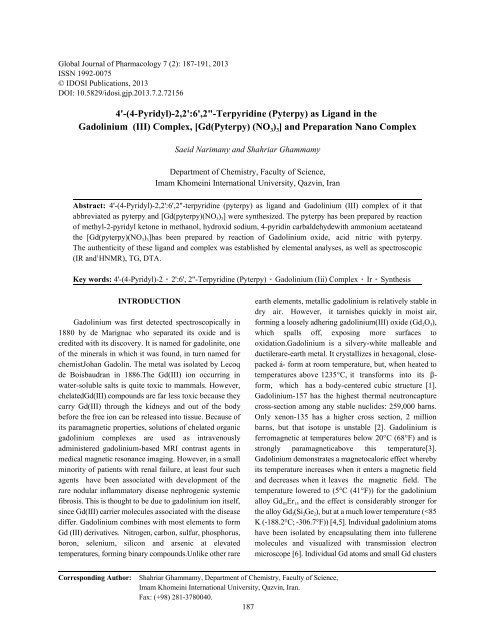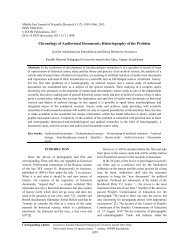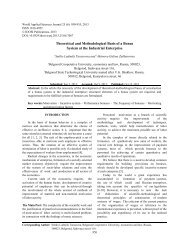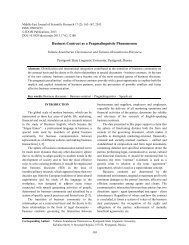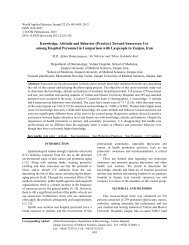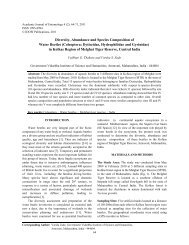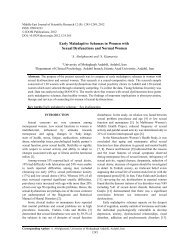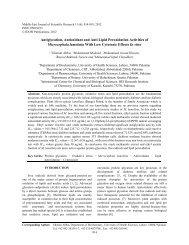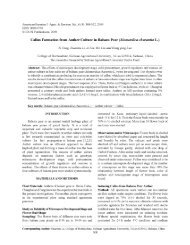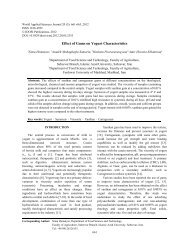4'-(4-Pyridyl)-2,2':6',2"-Terpyridine (Pyterpy) as Ligand in the ...
4'-(4-Pyridyl)-2,2':6',2"-Terpyridine (Pyterpy) as Ligand in the ...
4'-(4-Pyridyl)-2,2':6',2"-Terpyridine (Pyterpy) as Ligand in the ...
Create successful ePaper yourself
Turn your PDF publications into a flip-book with our unique Google optimized e-Paper software.
Global Journal of Pharmacology 7 (2): 187-191, 2013<br />
ISSN 1992-0075<br />
© IDOSI Publications, 2013<br />
DOI: 10.5829/idosi.gjp.2013.7.2.72156<br />
<strong>4'</strong>-(4-<strong>Pyridyl</strong>)-2,<strong>2'</strong>:<strong>6'</strong>,2"-<strong>Terpyrid<strong>in</strong>e</strong> (<strong>Pyterpy</strong>) <strong>as</strong> <strong>Ligand</strong> <strong>in</strong> <strong>the</strong><br />
Gadol<strong>in</strong>ium (III) Complex, [Gd(<strong>Pyterpy</strong>) (NO ) ] and Preparation Nano Complex<br />
3 3<br />
Saeid Narimany and Shahriar Ghammamy<br />
Department of Chemistry, Faculty of Science,<br />
Imam Khome<strong>in</strong>i International University, Qazv<strong>in</strong>, Iran<br />
Abstract: <strong>4'</strong>-(4-<strong>Pyridyl</strong>)-2,<strong>2'</strong>:<strong>6'</strong>,2"-terpyrid<strong>in</strong>e (pyterpy) <strong>as</strong> ligand and Gadol<strong>in</strong>ium (III) complex of it that<br />
abbreviated <strong>as</strong> pyterpy and [Gd(pyterpy)(NO 3) 3] were syn<strong>the</strong>sized. The pyterpy h<strong>as</strong> been prepared by reaction<br />
of methyl-2-pyridyl ketone <strong>in</strong> methanol, hydroxid sodium, 4-pyrid<strong>in</strong> carbaldehydewith ammonium acetateand<br />
<strong>the</strong> [Gd(pyterpy)(NO 3) 3]h<strong>as</strong> been prepared by reaction of Gadol<strong>in</strong>ium oxide, acid nitric with pyterpy.<br />
The au<strong>the</strong>nticity of <strong>the</strong>se ligand and complex w<strong>as</strong> established by elemental analyses, <strong>as</strong> well <strong>as</strong> spectroscopic<br />
1<br />
(IR and HNMR), TG, DTA.<br />
Key words: <strong>4'</strong>-(4-<strong>Pyridyl</strong>)-2 <strong>2'</strong>:<strong>6'</strong>, 2"-<strong>Terpyrid<strong>in</strong>e</strong> (<strong>Pyterpy</strong>) Gadol<strong>in</strong>ium (Iii) Complex Ir Syn<strong>the</strong>sis<br />
INTRODUCTION<br />
earth elements, metallic gadol<strong>in</strong>ium is relatively stable <strong>in</strong><br />
dry air. However, it tarnishes quickly <strong>in</strong> moist air,<br />
Gadol<strong>in</strong>ium w<strong>as</strong> first detected spectroscopically <strong>in</strong> form<strong>in</strong>g a loosely adher<strong>in</strong>g gadol<strong>in</strong>ium(III) oxide (Gd2O 3),<br />
1880 by de Marignac who separated its oxide and is which spalls off, expos<strong>in</strong>g more surfaces to<br />
credited with its discovery. It is named for gadol<strong>in</strong>ite, one oxidation.Gadol<strong>in</strong>ium is a silvery-white malleable and<br />
of <strong>the</strong> m<strong>in</strong>erals <strong>in</strong> which it w<strong>as</strong> found, <strong>in</strong> turn named for ductilerare-earth metal. It crystallizes <strong>in</strong> hexagonal, closechemistJohan<br />
Gadol<strong>in</strong>. The metal w<strong>as</strong> isolated by Lecoq packed á- form at room temperature, but, when heated to<br />
de Boisbaudran <strong>in</strong> 1886.The Gd(III) ion occurr<strong>in</strong>g <strong>in</strong> temperatures above 1235°C, it transforms <strong>in</strong>to its -<br />
water-soluble salts is quite toxic to mammals. However, form, which h<strong>as</strong> a body-centered cubic structure [1].<br />
chelatedGd(III) compounds are far less toxic because <strong>the</strong>y Gadol<strong>in</strong>ium-157 h<strong>as</strong> <strong>the</strong> highest <strong>the</strong>rmal neutroncapture<br />
carry Gd(III) through <strong>the</strong> kidneys and out of <strong>the</strong> body cross-section among any stable nuclides: 259,000 barns.<br />
before <strong>the</strong> free ion can be rele<strong>as</strong>ed <strong>in</strong>to tissue. Because of Only xenon-135 h<strong>as</strong> a higher cross section, 2 million<br />
its paramagnetic properties, solutions of chelated organic barns, but that isotope is unstable [2]. Gadol<strong>in</strong>ium is<br />
gadol<strong>in</strong>ium complexes are used <strong>as</strong> <strong>in</strong>travenously ferromagnetic at temperatures below 20°C (68°F) and is<br />
adm<strong>in</strong>istered gadol<strong>in</strong>ium-b<strong>as</strong>ed MRI contr<strong>as</strong>t agents <strong>in</strong> strongly paramagneticabove this temperature[3].<br />
medical magnetic resonance imag<strong>in</strong>g. However, <strong>in</strong> a small Gadol<strong>in</strong>ium demonstrates a magnetocaloric effect whereby<br />
m<strong>in</strong>ority of patients with renal failure, at le<strong>as</strong>t four such its temperature <strong>in</strong>cre<strong>as</strong>es when it enters a magnetic field<br />
agents have been <strong>as</strong>sociated with development of <strong>the</strong> and decre<strong>as</strong>es when it leaves <strong>the</strong> magnetic field. The<br />
rare nodular <strong>in</strong>flammatory dise<strong>as</strong>e nephrogenic systemic temperature lowered to (5°C (41°F)) for <strong>the</strong> gadol<strong>in</strong>ium<br />
fibrosis. This is thought to be due to gadol<strong>in</strong>ium ion itself, alloy Gd85Er 15 and <strong>the</strong> effect is considerably stronger for<br />
s<strong>in</strong>ce Gd(III) carrier molecules <strong>as</strong>sociated with <strong>the</strong> dise<strong>as</strong>e <strong>the</strong> alloy Gd 5(Si 2Ge 2),<br />
but at a much lower temperature (
Global J. Pharmacol., 7 (2): 187-191, 2013<br />
have also been <strong>in</strong>corporated <strong>in</strong>to carbon nanotubes [7]. of <strong>4'</strong>-(4-<strong>Pyridyl</strong>)-2, <strong>2'</strong>:<strong>6'</strong>, 2"-terpyrid<strong>in</strong>e (pyterpy) with<br />
<strong>Terpyrid<strong>in</strong>e</strong> (2,<strong>2'</strong>;<strong>6'</strong>,2"-terpyrid<strong>in</strong>e) is a heterocyclic<br />
1<br />
Gadol<strong>in</strong>ium (III)and identification <strong>the</strong>m with IR, HNMR,<br />
compound derived from pyrid<strong>in</strong>e. This colourless solid TG and DTA<br />
is used <strong>as</strong> a ligand <strong>in</strong> coord<strong>in</strong>ation chemistry.<br />
<strong>Terpyrid<strong>in</strong>e</strong> is a tridentate ligand that b<strong>in</strong>ds metals at<br />
MATERIALS AND METHODS<br />
three meridional sites giv<strong>in</strong>g two adjacent 5-membered<br />
MN2C 2chelate r<strong>in</strong>gs [8]. Gadol<strong>in</strong>ium comb<strong>in</strong>es with most All reagents were supplied by Merck and<br />
elements to form Gd(III) derivatives. nitrogen, carbon, were used without fur<strong>the</strong>r purification. The FT-IR<br />
sulfur, phosphorus, boron, selenium, silicon and spectra were recorded <strong>in</strong> <strong>the</strong> range 400–4000 cm<br />
1<br />
by KBr<br />
arsenic at elevated temperatures, form<strong>in</strong>g b<strong>in</strong>ary disk us<strong>in</strong>g a Bruker Tensor 27 M 420 FT-IR<br />
compounds [9]. <strong>Terpyrid<strong>in</strong>e</strong> forms complexes with spectrophotometer.<br />
most transition metalion <strong>as</strong> do o<strong>the</strong>r polypyrid<strong>in</strong>e<br />
compounds, such <strong>as</strong> 2,<strong>2'</strong>-bipyrid<strong>in</strong>e and 1,10- Syn<strong>the</strong>sis of <strong>the</strong> <strong>4'</strong>-(4-pyridyl)-2, <strong>2'</strong>:<strong>6'</strong>, 2"-terpyrid<strong>in</strong>e<br />
phenanthrol<strong>in</strong>e. Complexes conta<strong>in</strong><strong>in</strong>g two terpyrid<strong>in</strong>e (<strong>Pyterpy</strong>): The ligand pyterpy w<strong>as</strong> prepared by a reported<br />
n+<br />
complexes, i.e. [M(terpy) 2] are common. They differ<br />
1<br />
method [11]. Yield: 85%. M.p. 230-232°C, IR (KBr, /cm ):<br />
n+<br />
structurally from <strong>the</strong> related [M(bipy) 3] complexes <strong>in</strong> 3050 (aromatic C-H stretch), 1475, 1585 (aromatic C=C<br />
be<strong>in</strong>g achiral. <strong>Terpyrid<strong>in</strong>e</strong> complexes, like o<strong>the</strong>r<br />
1<br />
stretch), 1390 (C=N stretch). H NMR (300 MHz, DMSO,<br />
polypyrid<strong>in</strong>e complexes, exhibit characteristic optical and ppm): 7.54 (dd, J = 4.8, 6.15 Hz, 2H, H f), 7.94 (d, J = 4.8 Hz,<br />
electrochemical properties: metal-to-ligand charge transfer 2H, H b), 8.04 (t, J = 7.8 Hz, 2H, H e), 8.68 (d, J = 7.8 Hz,<br />
(MLCT) <strong>in</strong> <strong>the</strong> visible region, reversible reduction and 2H, H g), 8.76 (s, 2H, H c), 8.76-8.77 (4H, H a, H d). UV-Vis<br />
oxidation and fairly <strong>in</strong>tense lum<strong>in</strong>escence. Because <strong>the</strong>y (H2O, max/nm): 198, 238, 272, 312.(Fig 1, 2, Table1).<br />
are pi-acceptors, terpyrid<strong>in</strong>e and bipyrid<strong>in</strong>e tend to<br />
stabilize metals <strong>in</strong> lower oxidation states. For <strong>in</strong>stance <strong>in</strong> Syn<strong>the</strong>sis of <strong>the</strong> [Gd(pyterpy)(No 3) 3]complex<br />
acetonitrile solution, it is possible to generate <strong>the</strong> Refluxmethod: At first Gadol<strong>in</strong>ium oxide (0.25 mmol,<br />
+<br />
[M(terpyrid<strong>in</strong>e) 2] (M = Ni, Co). In recent years 0.091 g) reacted with nitric acid (1.5 mmol)<br />
considerable attention h<strong>as</strong> been drawn to <strong>the</strong> polymetallic tobeconvertedtogadol<strong>in</strong>iumnitrate(0.5mmol) were<br />
coord<strong>in</strong>ation architectures ma<strong>in</strong>ta<strong>in</strong>ed by covalent and dissolved <strong>in</strong> ammoniac and <strong>the</strong> below complex w<strong>as</strong><br />
non-covalent (supramolecular) <strong>in</strong>teractions <strong>in</strong> <strong>the</strong> formed. The result<strong>in</strong>g product w<strong>as</strong> heated until gado<br />
solid-state [10]. The N-donorsligands have been ei<strong>the</strong>r l<strong>in</strong>iumnitrate completely dry. Then <strong>the</strong> result<strong>in</strong>g<br />
exo-bidentate (divergent) [2–9] or chelat<strong>in</strong>g bis-bidentate productw<strong>as</strong> dissolved <strong>in</strong> methanol (2 ml). At <strong>the</strong> next<br />
[10].In this paper we report preparation of a new complex stage pyterpy (0.05 mmol, 0.016 g) w<strong>as</strong> dissolved <strong>in</strong><br />
Fig. 1: FTIR spectrum of pyterpy (KBr Disk)<br />
188
Global J. Pharmacol., 7 (2): 187-191, 2013<br />
1<br />
Fig 2: HNMR spectrum of pyterpy(<strong>in</strong> DMSO)<br />
Fig. 3: FTIR spectrum of [Gd(pyterpy)(NO3)3] (KBr Disk)<br />
Table1: FTIR spectral data (cm<br />
1) of pyterpy<br />
1<br />
(cm ) Vibration Intensity<br />
3050 w<br />
C-H<br />
1475 M<br />
C=C<br />
1585 s<br />
C=C<br />
1390 s<br />
C=N<br />
1<br />
Table 2: FTIR spectral data (cm ) of [Gd(pyterpy)(NO 3) 3]<br />
1<br />
(cm ) Vibration Intensity<br />
3085 w<br />
C-H<br />
1605 M<br />
C=C<br />
1478 s<br />
C=C<br />
1413 w<br />
C=N<br />
1291 s<br />
(NO3)<br />
methanol and added to <strong>the</strong> first solution. The result<strong>in</strong>g<br />
solution w<strong>as</strong> refluxed at 65°C and after one hour <strong>the</strong><br />
result<strong>in</strong>g white precipitate w<strong>as</strong> filtered. Yield 55%,<br />
1<br />
M.P.>300°C, white solid; IR (Kbr, /cm ): 3082<br />
(C-H arom), 1605, 1478 (aromatic C=C stretch), 1413 (C=N<br />
stretch), 1291 (NO 3), 1161, 1021, 797. UV-Vis (H2O,<br />
max/nm): 201, 240, 276, 287, 331. (Fig 3, 4,Table2).<br />
Ultr<strong>as</strong>onicmethods: To prepare this complex, <strong>4'</strong>-(4-<br />
<strong>Pyridyl</strong>)-2, <strong>2'</strong>:<strong>6'</strong>, 2"-terpyrid<strong>in</strong>e (pyterpy) w<strong>as</strong> dissolved <strong>in</strong><br />
methanol- dichloromethane (3:1)and w<strong>as</strong> added to<br />
gadol<strong>in</strong>iumnitrate <strong>in</strong> ethanol. Reaction mixturew<strong>as</strong><br />
placed<strong>in</strong> <strong>the</strong>ultr<strong>as</strong>onicbath, after 5 hour <strong>the</strong> result<strong>in</strong>g<br />
white precipitate w<strong>as</strong> filtered. Complexnanoscalew<strong>as</strong><br />
approved by SEMimages.<br />
189
Global J. Pharmacol., 7 (2): 187-191, 2013<br />
3<br />
Fig. 4: UV/Vis spectrum of [Gd(pyterpy)(NO 3) 3]and pyterpy(<strong>in</strong> acetonitrile, C=1×10 M)<br />
RESULTS AND DISCUSSION<br />
In this paper, a direct, simple and one step method h<strong>as</strong><br />
been used to syn<strong>the</strong>size <strong>the</strong>se compounds. The<br />
The purpose of build<strong>in</strong>g this complexis syn<strong>the</strong>sis of advantages of <strong>the</strong> method are; that <strong>the</strong>re is no side<br />
anew compound of gadol<strong>in</strong>ium and study on its char product, <strong>the</strong> reaction is quite f<strong>as</strong>t, <strong>the</strong>re are mild<br />
acterization is <strong>in</strong> l<strong>in</strong>e with <strong>the</strong> trans parency factor. This is conditions. This complexw<strong>as</strong> obta<strong>in</strong>ed <strong>in</strong> relatively high<br />
due to <strong>the</strong> constant presence of aromaticr<strong>in</strong>gs<strong>in</strong> <strong>the</strong> yield, 75%. The <strong>in</strong>frared spectrum of <strong>the</strong>se compounds<br />
structure factor enhance trans parency and improve w<strong>as</strong> obta<strong>in</strong>ed. The IR spectra of <strong>the</strong> pyterpy show<br />
efficiency. In this work, ligand is considered to be characteristic bands due to (CH), (C=C) and (C=N)<br />
comprised of four r<strong>in</strong>gs Pyrid<strong>in</strong>e. Interest<strong>in</strong>g properties,<br />
1<br />
<strong>in</strong> <strong>the</strong> region 3050, 1475, 1585 and 1390 cm respectively.<br />
electronic, photonic, magnetic and structural and In <strong>the</strong> c<strong>as</strong>e of [Gd(pyterpy)(NO 3) 3] complex we<br />
reactivity of <strong>the</strong> ligand<strong>in</strong> <strong>the</strong> metal complexe sof <strong>the</strong> observedcharacteristic bands due to (CH), (C=C),<br />
1 1<br />
seligands is anim portant factor. This lig and w<strong>as</strong><strong>in</strong> (C=N) and (NO 3)<strong>in</strong> <strong>the</strong> region 3085 cm , 1605 cm , 1478<br />
soluble <strong>in</strong> solvents such <strong>as</strong> diethyl e<strong>the</strong>r, ethanol, ethyl<br />
1 1<br />
cm ,1413 cm and 1291 cm<br />
1 1<br />
respectively. The H-NMR<br />
acetate, hexane, acetoneandwater and soluble <strong>in</strong> spectra of pyterpycompound displays a signal at 7.54 ppm<br />
dichlorome thane. This complex w<strong>as</strong> <strong>in</strong>soluble which is <strong>as</strong>signed to protons of H f, a signal at 7.94 ppm<br />
<strong>in</strong>solventssuch <strong>as</strong> diethyl e<strong>the</strong>r, ethyl acetate, hexane, which w<strong>as</strong> <strong>as</strong>signed to two protons of H b, a signal at 8.04<br />
acet one and water and soluble <strong>in</strong> ethanol and THF. ppm which is <strong>as</strong>signed to two protons of H .<br />
e<br />
Fig. 5: Thermal analysis data of [Gd(pyterpy)(NO ) ] complex<br />
3 3<br />
190
Global J. Pharmacol., 7 (2): 187-191, 2013<br />
Fig 6: [Gd(pyterpy) (NO ) ]morphology<br />
3 3<br />
Thermogravimetric Analyses: The <strong>the</strong>rmal properties of<br />
REFRENCES<br />
[Gd(pyterpy) (NO 3) 3] w<strong>as</strong> <strong>in</strong>vestigated by <strong>the</strong>rmograms<br />
(TG/ DTA). Figure 5 shows TGA and DTA curves for 1. Roesky, H.W. and M. Andruh, 2003. The <strong>in</strong>terplay of<br />
[Gd(pyterpy)(NO 3) 3]. In <strong>the</strong> temperature range 420°C, a coord<strong>in</strong>ative, hydrogen bond<strong>in</strong>g and %- % stack<strong>in</strong>g<br />
weight los<strong>in</strong>g w<strong>as</strong> observed which w<strong>as</strong> related to <strong>the</strong> <strong>in</strong>teractions <strong>in</strong> susta<strong>in</strong><strong>in</strong>g supramolecular solid<br />
degradationand evaporation of pyterpy.<br />
statearchitectures.: A study c<strong>as</strong>e of bis(4-pyridyl)-<br />
and bis(4-pyridyl-Noxide) tectons. Coord. Chem.<br />
SEM Pictures: Scann<strong>in</strong>g Electron Microscope image of Rev., 236: 91-119.<br />
[Gd(pyterpy)(NO 3) 3] with different magnification h<strong>as</strong> been 2. Zaman, M.B., M.D. Smith, D.M. Ciurt<strong>in</strong> and<br />
shown (Fig 6).<br />
H.C. Zur Loye, 2002. New Cd(II), Co(II) and Cu(II)<br />
CONCLUSION<br />
Conta<strong>in</strong><strong>in</strong>g Coord<strong>in</strong>ation Polymers Syn<strong>the</strong>sized<br />
us<strong>in</strong>g <strong>the</strong> Rigid <strong>Ligand</strong> 1,2-bis(3-pyridyl)ethyne<br />
(3,3'-DPA)” Inorg. Chem, 41: 4895-4903.<br />
In summary, <strong>the</strong> syn<strong>the</strong>sis and characterization of 3. Barnett, S.A., N.R. Blake, J.E.B. Champness,<br />
complexes have been described pyterpy and [Gd C. Nicolson and J. Wilson, 2001. Chem. Soc. Dalton<br />
(pyterpy) (NO 3) 3] w<strong>as</strong> syn<strong>the</strong>sized simply. These Trans., pp: 567-573.<br />
1<br />
compounds w<strong>as</strong> Characterized by IR and HNMR, UV-Vis 4. Zaman, M.B., N.R. Smith Champness,<br />
and TG/DTA.<br />
J.E.B.C. Nicolson and J. Wilson, 2001. Chem. Soc.<br />
ACKNOWLEDGMENTS 5.<br />
Dalton Trans, pp: 567.<br />
Dong, Y.B., R.C. Layland and D.N.G. Smith, 1999.<br />
We gratefully acknowledge <strong>the</strong> f<strong>in</strong>ancial support 6.<br />
Inorg. Chem., 38: 3056.<br />
Fujita, M., Y.J. Kwon, O.K. S<strong>as</strong>aki and K. Yamaguchi,<br />
from <strong>the</strong> Research Council of Takestan Islamic Azad 1995. J. Am. Chem. Soc., 117: 7287.<br />
University and many technical supports that provided by 7. Plater, M.J., M.R. Foreman, J. Tst, Gelbrich, S.J. Coles<br />
TarbiatModarres University.<br />
and M.B. Hursthouse, 2000. J. Chem. Soc. Dalton<br />
Trans., pp: 3065.<br />
8. Bujaci, M.T.X. S WangandLiZheng, (2002).Inorg.<br />
Chim. Acta, 333: 152.<br />
9. Khlobystov, A.K., M.T. Brett, A.J. Blake,<br />
N.R. Champness, P.M.W. Gill, D.P. Neill, O.S. Teat,,<br />
J.C. Wilson and M. Schr_oder, 2003. J. Am. Chem.<br />
Soc., 125: 6753.<br />
10. Neels, A. and H. Stoeckli-Evans, 1999. Inorg. Chem.,<br />
38: 6164.<br />
191


